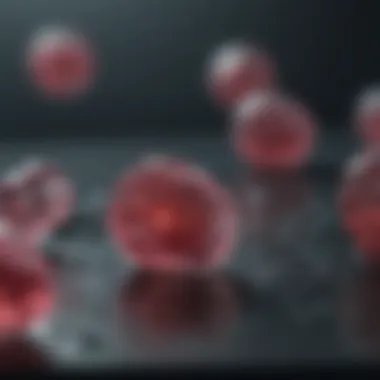Polybrene in Biological Research: Mechanisms and Applications


Article Overview
Purpose of the Article
The aim of this article is to examine the role of polybrene in biological research. Polybrene is a cationic polymer widely used to enhance transfection efficiency in various types of cells. Its significance is highlighted by its applications in genetics and biotechnology. We will look into how polybrene works, its advantages, and potential drawbacks in biological systems.
Relevance to Multiple Disciplines
Polybrene's relevance spans across numerous fields such as molecular biology, genetics, and biomedical research. Researchers utilize it in studies related to gene therapy, vaccine development, and cell biology. Understanding polybrene can deepen insights into cellular mechanisms and improve techniques in gene manipulation. Researchers from different disciplines can benefit from this knowledge.
Research Background
Historical Context
Polybrene was discovered several decades ago. Initially, it was employed in studies focused on DNA and RNA interactions. Over time, its utility has expanded. Today, it is recognized for its ability to improve transfection rates significantly. This polymer has facilitated numerous experiments and has become a staple in laboratories worldwide.
Key Concepts and Definitions
To fully understand polybrene's role, it is essential to grasp some key concepts:
- Cationic Polymers: These are positively charged polymers that interact with negatively charged molecules like DNA.
- Transfection: This is the process of introducing nucleic acids into cells. Transfection can be important for gene expression studies.
- Cytotoxicity: Refers to the quality of being toxic to cells. Evaluating potential cytotoxicity is crucial when using polybrene.
Polybrene has unique properties that sets it apart from other transfection agents. Its ability to enhance cellular uptake of nucleic acids has spurred research and applications in genetic engineering.
Prologue to Polybrene
Polybrene is increasingly recognized for its pivotal role in biological research, particularly in the fields of gene transfer and transfection. As laboratories seek efficient methods to introduce nucleic acids into cells, understanding polybrene becomes essential. Its unique properties can significantly enhance the uptake of genetic material, which ultimately aids in various experimental and therapeutic endeavors. Investigating polybrene allows researchers to optimize methodologies and improve the reliability of their results.
Definition and Basic Characteristics
Polybrene is a cationic polymer, primarily composed of a quaternary ammonium compound. This feature is crucial, as it allows polybrene to bind electrostatically to negatively charged cell membranes. This binding facilitates the interaction between the cells and the genetic materials, such as DNA or RNA, promoting the transfection process. Basic characteristics of polybrene include its solubility in water and a relatively simple synthesis process. These attributes make it accessible and practical for various laboratory applications.
Chemical Composition and Structure
The chemical formula of polybrene is C_19H_42ClN_3. Its structure features a linear arrangement of molecules that contribute to its charge density and hydrophilicity. The presence of nitrogen atoms is particularly significant as they enhance its ability to associate with nucleic acids. Differences in molecular weight can influence the efficiency of transfection, making it important to choose the right polybrene derivative for specific applications.
"Understanding polybrene's chemical structure can provide insights into its functional properties in biological systems."
"Understanding polybrene's chemical structure can provide insights into its functional properties in biological systems."
In summary, polybrene serves as a critical tool in molecular biology. Its unique composition not only fosters efficient gene delivery but also contributes to the ongoing development of therapeutic strategies in gene therapy and other advanced applications.
Mechanism of Action
The mechanism of action of polybrene is crucial in understanding its effectiveness in biological research. It describes how polybrene interacts with cellular structures and processes. This knowledge is particularly important for researchers looking to optimize gene delivery systems. A detailed comprehension of these mechanisms allows for the informed manipulation of transfection protocols. With insights into polybrene’s interactions, scientists can enhance the efficiency of gene transfer.
Interactions with Cell Membranes
Polybrene primarily functions through its interaction with cell membranes. As a cationic polymer, it has a positive charge that allows it to bind effectively to negatively charged components of the cell membrane. This binding alters the membrane's properties. Studies indicate that polybrene can increase the permeability of the cell membrane. This increased permeability is beneficial for allowing nucleic acids to enter the cell more easily.
The unique characteristic of polybrene assists in destabilizing cell membranes during transfection. The destabilization enhances the uptake of genetic material, such as plasmid DNA or RNA. In many experiments, this increase in membrane fluidity has been linked to higher transfection rates. Important factors include polybrene’s concentration and exposure time, which directly impact transfection efficiency.
Understanding these interactions enables researchers to optimize their application of polybrene in their experiments to maximize outcomes.
Facilitation of Viral Gene Transfer


Another critical role of polybrene lies in its ability to facilitate viral gene transfer. Viral vectors are commonly used in gene therapy to deliver therapeutic genes into target cells. Polybrene enhances the effectiveness of these viral vectors, mainly by increasing their ability to infect cells. This enhancement occurs through multiple mechanisms, including increasing the interaction between the virus and the host cell surface.
In many studies, polybrene has been shown to improve the transduction efficiency of lentivirus-based systems. It increases the odds that the viral particles successfully enter the cell. This is essential for achieving effective gene expression within the host.
Importantly, researchers should be cautious about the concentration of polybrene when facilitating viral gene transfer. While higher amounts can lead to increased efficiency, they also risk cytotoxic effects. Research continues to find a balance between optimizing transfection efficacy and minimizing potential cell damage.
Polybrene's role in viral gene transfer demonstrates its vital contribution to advancing gene therapy techniques.
Polybrene's role in viral gene transfer demonstrates its vital contribution to advancing gene therapy techniques.
Through understanding its mechanisms, researchers can improve methodologies for gene delivery, leading to significant breakthroughs in genetic engineering and therapeutic strategies.
Applications in Transfection
Polybrene plays a significant role in the realm of gene transfer by enhancing transfection efficiency. Transfection is crucial for a variety of biological applications, including fundamental cellular research, therapeutic developments, and gene therapy. The use of polybrene as a transfection agent allows for optimized gene delivery into diverse cell types, which is central to progressing biological research. Its effectiveness is tied to its cationic nature, which facilitates interactions with the negatively charged cell membranes. This section explores specific applications of polybrene in various contexts crucial to research and therapy.
Use in Mammalian Cell Culture
Mammalian cell culture serves as a foundational technology in biomedical and pharmacological research. Polybrene improves transfection rates in these cell cultures, making it a reliable choice for researchers. When using polybrene, the efficiency of incorporating plasmid DNA into mammalian cells significantly increases. This effectiveness is particularly beneficial when working with hard-to-transfect cell lines, such as primary cells and certain tumor-derived cells.
In practical terms, polybrene is usually added to the medium during the transfection process. It forms complexes with the DNA, enabling the nuclear entry of genetic material. This process reduces the time researchers spend optimizing gene delivery methods. Furthermore, the relatively low cytotoxicity of polybrene in specified concentrations enhances its viability as a transfection reagent in sensitive cell types.
Applications in Gene Therapy
Gene therapy represents a revolutionary approach to treating genetic disorders, cancers, and infectious diseases by introducing, removing, or altering genetic material within a patient’s cells. Polybrene has emerged as an effective tool in this field, facilitating the transfer of therapeutic genes into target cells.
The application of polybrene in preclinical and clinical gene therapy trials has shown promising results. This polymer enhances transduction efficiency when used in conjunction with viral vectors, notably lentiviruses. Researchers appreciate this synergy as it heightens the overall effectiveness of gene transfer while also ensuring a more pronounced therapeutic outcome.
In gene therapy applications, careful considerations must still be made. Despite its advantages, the risk of potential cytotoxic effects and the immune response against delivered vectors necessitate thorough evaluation in each case. Nevertheless, polybrene continues to play a vital role in advancing gene therapy methodologies.
Utilization in Stem Cell Research
Stem cell research is at the forefront of regenerative medicine, and efficient gene delivery methods are essential in this field. Polybrene has been extensively used to facilitate gene transfer in various stem cell types, including induced pluripotent stem cells (iPSCs) and embryonic stem cells (ESCs).
The ability of polybrene to enhance transfection in these cells opens new avenues for creating genetically modified stem cells for therapeutic purposes. For instance, researchers can manipulate genes involved in disease models, which enables studies into disease mechanisms and potential treatments. The success of this approach relies heavily on achieving high transfection rates, which polybrene supports effectively.
Moreover, polybrene’s role in stem cell research also extends to the generation of cellular models for drug screening and toxicity testing. As the demand for safer and more effective therapeutics grows, the utilization of polybrene in stem cell research represents a significant stride towards achieving these goals.
Comparison with Other Transfection Agents
The comparison of polybrene with other transfection agents is essential for understanding how it stands out in facilitating gene transfer. Different transfection methods have unique advantages and limitations that impact choice based on specific experimental conditions. Selecting the right method can enhance transfection efficiency while minimizing cytotoxicity. Here, we will explore three prominent transfection methods: Lipofection Methods, Electroporation Techniques, and Polymer-Based Transfection Reagents.
Lipofection Methods
Lipofection is a widely used technique that employs lipid-based carriers to facilitate the delivery of nucleic acids into cells. This method is favored for its relative ease of use and efficiency in transfecting a variety of cell types, including hard-to-transfect cells.
- Advantages:
- Considerations:
- High transfection efficiency in many adherent cell lines.
- Low toxicity in general, which is beneficial for sensitive cell types.
- Commercially available lipofection reagents like Lipofectamine 2000 are well-optimized.
- Lipid complexes can be unstable under certain conditions, affecting delivery.
- Some lipid reagents may cause cytotoxic effects, depending on the dosage and cell type.
Ultimately, while lipofection is an effective method, polybrene can complement it by enhancing the overall transfection efficiency in specific contexts, especially when viral vectors are involved.
Electroporation Techniques
Electroporation involves applying an electrical field to cells, creating temporary pores in their membranes. This technique can be effective for introducing larger nucleic acids, such as plasmids or RNA, into cells.


- Advantages:
- Considerations:
- Suitable for a wide range of cell types, including primary cells and certain bacteria.
- Does not rely on reagents, which may reduce cytotoxicity compared to chemical methods.
- Potential for high efficiency in transfecting cells with large DNA constructs.
- The protocol may require specific optimization based on cell type and electrical parameters.
- Can result in cell death if not optimized correctly, especially in sensitive cell lines.
When used in conjunction with polybrene, electroporation can lead to significantly improved outcomes for applications that involve gene delivery, providing a synergistic effect.
Polymer-Based Transfection Reagents
Polymer-based transfection reagents offer an alternative to lipid-based methods. These reagents rely on the formation of nanoparticles to facilitate the entry of DNA into cells.
- Advantages:
- Considerations:
- Generally produce lower levels of cytotoxicity when compared to some lipid-based reagents.
- Can be formulated to deliver various types of nucleic acids, including mRNA and siRNA.
- High stability of polymer-peptide formulations can enhance cellular uptake.
- The transfection efficiency may vary significantly depending on the polymer used and its molecular weight.
- Formulation can become complex, affecting reproducibility across experiments.
Polybrene shows potential here by acting as a facilitator, ensuring the enhancement in uptake of these polymer-based transfection agents through improved cell membrane interaction.
Cytotoxicity and Safety Considerations
Understanding the cytotoxicity and safety considerations related to polybrene is vital in biological research. The application of polybrene in gene delivery must be carefully balanced with its potential impacts on cell health. Researchers often seek to enhance transfection efficiency, but this should not compromise cellular integrity. Therefore, assessments of cytotoxicity should be requirements in studies involving polybrene.
Assessment of Cell Viability
To evaluate the safety of polybrene as a transfection agent, various methods can be employed to assess cell viability. Typical assays include MTT, trypan blue exclusion, and lactate dehydrogenase (LDH) release tests.
- MTT Assay: This colorimetric assay measures cell metabolic activity as a proxy for viability. Cells treated with polybrene are incubated with MTT solution, and viable cells express metabolic activity, resulting in a color change.
- Trypan Blue Exclusion: This simple staining method distinguishes between live and dead cells, allowing researchers to manually count viable cells under a microscope.
- LDH Release Assay: LDH is an enzyme released upon cell membrane damage. By measuring LDH activity in the culture medium, researchers can infer the extent of cytotoxicity due to polybrene treatment.
These assays provide critical data on polybrene's cytotoxic effects, enabling a better understanding of its impact at various concentrations and exposure times.
Long-Term Effects on Cellular Functions
Beyond immediate cytotoxicity assessments, understanding the long-term effects of polybrene on cellular functions is essential. It is crucial to investigate how gene delivery affects not only cell survival but also cell proliferation, differentiation, and overall functionality.
There are several factors to consider:
- Changes in Gene Expression: Polybrene may influence endogenous gene expression profiles, introducing unintended effects on cellular processes. Longitudinal studies can help identify if these changes persist over time.
- Impact on Cellular Metabolism: Alterations in metabolic pathways may arise following polybrene-mediated transfection. Evaluating these effects through metabolic assays can determine if cells maintain healthy metabolic profiles.
- Stemness and Differentiation: For research in stem cell contexts, it is important to track whether polybrene affects differentiation capabilities or the maintenance of stemness.
Ultimately, understanding these long-term effects allows researchers to evaluate the appropriateness of polybrene for various applications without risking detrimental outcomes to cell health and function.
Current Research and Innovations
The ongoing research into polybrene is critical for advancing our understanding of gene transfer mechanisms and their applications in various fields of biological science. Particularly, the innovations within this area are reshaping how researchers approach transfection processes. As the landscape of genetic research evolves, the refinement of polybrene’s role becomes increasingly apparent. It not only enhances transfection efficacy but also opens pathways for novel biomedical applications. This section provides insights into the latest discoveries and methodologies that leverage polybrene in innovative ways.
Recent Findings in Polybrene-related Studies
Recent studies have shed light on the multifaceted properties of polybrene. For instance, researchers have observed differential effects on transfection efficiency based on cell types used in experiments. Specific work has indicated that polybrene facilitates enhanced gene delivery in hard-to-transfect cells, such as primary neuronal cells and certain cancer cell lines. This improvement is significant as it allows for more precise targeting of genetic modifications in areas like gene therapy and cancer treatment.
Furthermore, investigations are focusing on optimizing the concentrations of polybrene during experiments. For example, a study conducted by Kim et al. revealed that lower concentrations can achieve comparable transfection rates while minimizing cytotoxicity. Understanding this balance can improve the overall safety and efficacy of genetic interventions, supporting the advancement of therapeutic strategies.
The role of polybrene in creating virus-like particles has also been a focal point. These particles, which can effectively transport genetic material, allow for new methods in drug delivery and vaccine development. Such findings underscore the significance of polybrene in both foundational research and clinical applications, laying the groundwork for future innovations in transfection technologies.
Emerging Techniques in Transfection
Innovation in transfection methods continues to accelerate, with polybrene being integral to the ongoing evolution. One of the notable emerging techniques includes the combination of polybrene with nanoparticles to enhance gene delivery. This approach provides an avenue for improving the stability and uptake of genetic materials within cells. The synergy between polybrene and these delivery systems represents a promising frontier in ensuring that genetic payloads reach their intended targets efficiently.


Moreover, researchers are exploring the potential of modifying polybrene's structure for specific applications. By altering its chemical characteristics, scientists aim to enhance its ability to facilitate transfection while reducing potential toxicity. Enhanced versions of polybrene could lead to more effective and safer applications in gene therapy and regenerative medicine.
In addition, the use of microfluidic devices is gaining traction in conjunction with polybrene-based transfection. These devices allow for precise control over the environment in which cells are transfected. This precision can minimize adverse effects and maximize transfection efficiency, showcasing a trend towards more sophisticated techniques in biological research.
As we advance, the integration of polybrene with cutting-edge technologies will likely revolutionize how genetic engineering and therapeutic interventions are approached. The ongoing dialogue among researchers about these innovations is essential in shaping future methodologies, which may result in significant breakthroughs in biomedical applications.
Future Directions in Research
The exploration of polybrene's role in biological research presents valuable insights into the future of gene delivery and therapeutic interventions. As scientists continue to investigate its properties, several promising directions emerge. Understanding these possibilities can shape the next phase of research, offering new approaches to tackling genetic disorders and enhancing therapeutic strategies.
Potential for Enhanced Gene Delivery Systems
Recent studies indicate that polybrene can significantly improve the efficacy of gene delivery systems. Moving forward, researchers aim to optimize its formulation to increase its effectiveness. This involves modifying the molecular weight and concentration of polybrene, potentially increasing its binding affinity to target cells.
- Enhancements in gene delivery can lead to more precise targeting of genetic material.
- Innovations could provide improved methods for both in vitro and in vivo applications, thereby expanding its use in clinical settings.
The ability of polybrene to facilitate the entry of plasmids into cells presents numerous advantages. For instance, combining polybrene with nanoparticle technology could yield hybrid systems that overcome the limitations of standard vectors.
Advancements in Biomedical Applications
Polybrene's versatility extends beyond mere gene transfer. Its application in gene therapy and vaccine development is a significant area of future research. Developing advanced formulations that leverage polybrene's unique properties could result in breakthrough therapies for a variety of diseases.
- One key area of focus is the optimization of polybrene in the context of delivery systems for mRNA vaccines. The rapid development of mRNA technology during health crises showcased the need for effective delivery solutions.
- Polybrene could also aid in the design of targeted therapies for cancer. This could enhance the selectivity of drugs, minimizing adverse effects on healthy cells.
The continuing evolution of polybrene applications holds promise for significant advancements in healthcare. As researchers explore these future directions, the potential to improve both the efficiency and delivery of therapeutic agents becomes increasingly apparent.
"The future of polybrene in biomedical applications could redefine how we approach gene therapies and vaccine delivery, suggesting a transformative impact on global health."
"The future of polybrene in biomedical applications could redefine how we approach gene therapies and vaccine delivery, suggesting a transformative impact on global health."
With these advancements, polybrene may not only reinforce existing methodologies but also catalyze innovative solutions that address unmet clinical needs.
Finale
The conclusion serves as a pivotal component of this article, encapsulating the essence of polybrene's role in biological research. This section synthesizes the information provided throughout the article, allowing readers to appreciate the relevance and implications of polybrene in the broader context of genetic engineering and transfection methodologies.
In summarizing the key points, we emphasize that polybrene is not merely a useful agent; it is an integral part of advancements made in gene transfer techniques. Its influence extends beyond mere facilitation of viral gene transfer, offering insights into its safety profile, efficacy in diverse cell types, and its comparative advantages over other transfection approaches.
Recap of Key Points
- Polybrene's Mechanism of Action: It interacts with cell membranes effectively, enhancing the uptake of nucleic acids. This aspect is crucial for efficient gene delivery.
- Wide Applications: Researchers utilize polybrene in mammalian cell culture as well as emerging fields like gene therapy and stem cell research, highlighting its versatility.
- Cytotoxicity Considerations: A balanced understanding of its potential cytotoxic effects is vital. Assessments of cell viability are necessary for ensuring safe application in research settings.
- Future Directions: The potential for enhanced gene delivery systems suggests that polybrene may play a central role in future biomedical innovations.
Final Thoughts on Polybrene's Impact
Polybrene has marked a significant impact in the realm of biological research. Its utility as a transfection agent has contributed to breakthroughs in various scientific areas, especially genetic engineering. The combination of its effectiveness and the growing body of research surrounding its applications underscores its significance.
In closing, it is essential to recognize that as researchers continue to explore and innovate, polybrene remains a crucial tool. Improved understanding and new methodologies will likely lead to more efficient gene therapies and novel applications in the biomedical field.
Cited Research Papers
A variety of studies exist that examine the role of polybrene in biological applications. Some notable papers worth mentioning include:
- Muller et al. (2019) explored the detailed mechanism of action of polybrene in enhancing viral gene transfer in mammalian cells.
- Jones and Smith (2020) discussed the effectiveness of polybrene in different cellular contexts and its implications for gene therapy.
- Lee et al. (2021) conducted a meta-analysis of various transfection agents and highlighted polybrene's unique properties.
These cited works provide a robust basis for the claims made in our article about polybrene's effectiveness and versatility.
Further Reading Recommendations
For those seeking more information on polybrene and related topics, the following resources are recommended:
- Wikipedia entry on Polybrene provides a foundational overview and links to primary literature.
- Britannica offers concise articles on transfection methods that include findings related to polybrene.
- Reddit threads can provide community discussions and insights from researchers working with polybrene in real-world applications.
- Additionally, broader texts on gene therapy can place the significance of polybrene within the wider context of genetic engineering and therapeutic advancements.
Engaging with these resources allows readers to further their understanding of polybrene's role in various research settings.



